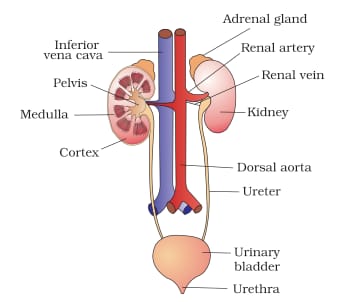MCQ ON EXCRETORY PRODUCTS AND THEIR ELIMINATION class 12 for NEET | EXCRETORY PRODUCTS AND THEIR ELIMINATION class 12 | MCQ EXCRETORY PRODUCTS AND THEIR ELIMINATION with Answer | Check the below NCERT MCQ question for class 12 Biology based on the with Answers.
MCQ on EXCRETORY PRODUCTS AND THEIR ELIMINATION class 12 Biology with answers were prepared based on the latest pattern.We have provided class 12 Biology MCQs question with Answers to help students understand the concept very well.

MCQ ON EXCRETORY PRODUCTS AND THEIR ELIMINATION class 12 for NEET
MCQ ON EXCRETORY PRODUCTS AND THEIR ELIMINATION is useful for NEET / CSIR / UGC / CBSE / ICSE / AIIMS / EXAM / AFMC EXAM / STATE LEVEL MEDICAL EXAM/ KVS PGT BIOLOGY / NVS PGT BIOLOGY EXAM 2023-2024 ,2025
INTRODUCTION:-
Animals temporarily accumulate nitrogenous wastes Ammonia, urea , uric acid , Carbon dioxide, water , ions , pigments, spices.
This substances waste material maybe group into two categories volatile and non-volatile. Carbon dioxide is volatile and is lost as gas from the respiratory surface. Water is volatile and only a part of it eliminated from the respiratory surface or skins.
Nitrogenous wastes materials formed principal excretory product. They are mainly formed as the end products of protein metabolism.
Small amounts are formed by metabolism of nucleic acids. The nitrogenous wastes are produced in two ways:
Deamination of excess and unwanted amino acid present in the food taken and breakdown of body own protein and nucleic acid.
MCQ EXCRETORY PRODUCTS AND THEIR ELIMINATION class 12 for NEET/KVS PGT BIOLOGY / NVS PGT BIOLOGY EXAM 2022-2023,2024
1. Uric acid is the chief nitrogenous components of excretory production of
(a) frog
(b) man
(c) earthworm
(d) cockroach
Ans (d) cockroach
2. The following substances are excretory products in animals , choose the least toxic forms among them
(a) urea
(b) uric acid
(c) ammonia
(d) carbon dioxide
Ans. (b) uric acid
3. Filtration of the blood takes place at
(a) PCT
(b) DCT
(c) Collecting duct
(d) Malpighian body
Ans. (d) Malpighian body
4. A large quantity of one of the following is removed from our body by lungs
(a) CO2 only
(b) H2O only
(c) CO2 and H2O
(d) ammonia
Ans.(c) CO2 and H2O
5. pH of human urine is approximately
(a) 6.5
(b) 7
(c) 6
(d) 7.5
Ans.(c) 6
6. The condition of accumulation of urea in the blood is termed as
(a) renal calculi
(b) glomerulonephritis
(c) uremia
(d) ketonuria
Ans.(c) uremia
7. Which of the following is also known as antidiuretic hormone ?
(a) oxytocin
(b) Vasopressin
(c) Adrenaline
(d) Calcitonin
Ans.(d) Vasopressin
8. Dialysing unit contains a fluid which is almost same as plasma except that it has
(a) high glucose
(b) high urea
(c) no urea
(d) high uric acid
Ans.(b) high urea
9. What is glycosuria ?
(a) low amount of sugar in urine
(b) low amount of fat in urine
(c) average amount of carbohydrate in urine
(d) hi amount of sugar in urine
Ans. (d) high amount of sugar in urine
10. Volume of urine is regulated by
(a) aldosterone
(b) aldosterone and testosterone
(c) ADH
(d) aldosterone and ADH
Ans. (d) aldosterone and ADH
11. Name the condition when the concentration of ketone body increase in urine
(a) acromegaly
(b) diabetes insipidius
(c) diabetes mellitus
(d) both a and b
Ans.(c) diabetes mellitus
12. This is not a nitrogenous waste
a) creatinine
b) purines
c) allantoin
(d) citrulline
Ans . (d) citrulline
13. Which one of the following is not part of renal pyramid ?
(a) peritubular capillaries
(b) convulated tubules
(c) collecting ducts
(d) loop of Henle
Ans.(b) convulated tubules
14. Loop of Henle is found in
(a) lung
(b) liver
(c) neuron
(d) nephron
Ans. (d) nephron
ALSO READ:-
● YOU CAN WATCH BIOLOGY SIR Youtube channel
15. Which of the following causes an increase in sodium reabsorption in the distal convulated tubule ?
(a) increase in aldosterone levels
(b) increase in antidiuretic hormone levels
(c) decrease in aldosterone levels
(d) decrease in antidiuretic hormone levels.
Ans.(a) increase in aldosterone levels.
16.In mammals , which of the blood vessels would normally carry largest amount of urea ?
(a) Dorsal aorta
(b) Hepatic vein
(c) Hepatic portal veins
(d)Renal vein
Ans.(b) Hepatic vein







Leave a Comment